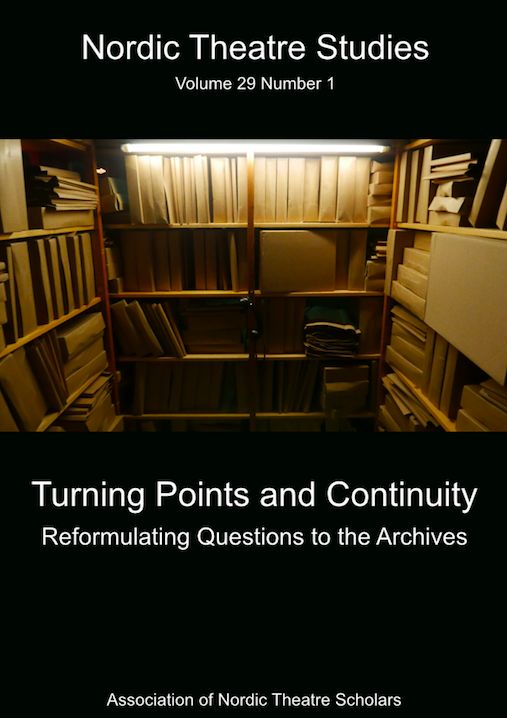Embodied Spectatorship? Interpreting dance reviews around 1900
DOI:
https://doi.org/10.7146/nts.v29i1.103305Keywords:
Embodied responses, kinaesthesia, dance reviews, Isadora Duncan, Loïe Fuller, female spectatorship, amateur dancingAbstract
The article intertwines historiographical analyses with research methods focusing on embodied responses to performances. It argues that dance reviews can be interpreted from a sensorial viewpoint, analyzing ways in which language articulates so-called kinaesthetic, or affective responses. The argument is based on theories of agency and embodiment (Noland). Swedish reviews from performances by Isadora Duncan (Stockholm, 1906), Artemis Colonna (Stockholm, 1903), and Loïe Fuller (Gothenburg, 1907) are investigated, and it is concluded that these kinaesthetic sensations are visible mainly in the language of female writers and spectators. Moreover, in arguing that an embodied spectatorship is important in order to understand the view of the period as a turning point in dance aesthetics, an emphasis is put on the importance of including the practice of dancing by both professionals and amateurs in this historical narrative. Besides embracing the emergence of the professional dance avant-garde, the interpretation focuses on the importance of a corporeal education of the audience. In particular, female audience members seem to, via a dance performance, identify with forms of sensory experience in tandem with visually evaluated objects of art. It is argued that the change in the female viewers’ perceptions had a potential political effect in that it gave voice to both corporeal sensations and women’s experiences in ways new to the public arena. Thus, it is in these experiences the important turning point in dance history emerges, rather than merely in the performances themselves.References
Albright, Ann Cooper. 2007. Traces of Light: Absence and Presence in the Work of Loïe Fuller. Middletown, Connecticut: Wesleyan UP.
Baltiska utställningen, Malmö Stad. http://malmo.se/Kultur--fritid/Kultur--no- je/Arkiv--historia/Kulturarv-Malmo/A-D/Baltiska-utstallningen.html (accessed 2017-04-01).
Behle, Anna. “Memoirs”, unpublished manuscript. Anna Behle’s Collection, The Dance Museum, Stockholm.
Behle, Anna. 1918. “Några ord om rytm och plastik”. Jorden Rundt, 14-16.
Bergman, Gösta M. 1966. Den moderna teaterns genombrott 1890-1925. Stockholm: Bonniers förlag.
Branting, Anna. 1906. Stockholmstidningen, 2 May.
Bryan-Wilson, Julia. 2012. “Practicing Trio A”. OCTOBER 140. Spring, 54-74.
Carter, Alexandra. 2005. “London 1908: A Synchronic View of Dance History”. Dance Research 23 (1), 36-47.
Conner, Lynne. 1997. Spreading the Gospel of the Modern Dance: Newspaper Criticism in the Unites States 1850-1934. Pittsburgh: University of Pittsburgh Press.
Dasgupta, Sudeep. 2008. “Art is Going Elsewhere, and Politics has to Catch it. An Interview with Jacques Rancière”. Krisis: Journal for Contemporary Philosophy. 2008:1, 70-6.
Elswit, Kate. 2014. Watching Weimar Dance. New York: Oxford UP. Fuller, Loïe, Program.
Göteborgs Stadsmuseum, Stora teaterns programsamling.
Guest, Ivor. 1992. Ballet in Leicester Square. London: Dance Books.
Göteborgs Handels och Sjöfarts-tidning, 10 April 1906.
Göteborgs Handels och Sjöfarts-tidning, 14 April 1906.
Göteborgs Handels och Sjöfarts-tidning, 18 April 1906.
Göteborgs-Posten, 18 April 1906.
Göteborgs-Posten, 20 April 1906.
Hammergren, Lena. 2002. Ballerinor och barfotadansöser: Svensk och internationell danskultur runt 1900. Stockholm: Carlssons förlag.
Hammergren, Lena. 1995. “Different Personas: A History of One’s Own?”. In S.L. Foster (ed.). Choreographing History. Bloomington & Indianapolis: Indiana UP, 185-92.
Idun. 1906. vol. 19, no. 8.
Karlsson, Mats. “Knäppupp! Om blixtlåsets historia”. http://popularhistoria.se/artiklar/knappupp-om-blixtlasets-historia/ (accessed, 2017-04-01).
Laurin, Carl. G. 1903. ”Från Stockholms teatrar”. Ord och bild, vol. XII.
Laurin, Carl. G. 1906. ”Från Stockholms teatrar”. Ord och bild, vol. XV.
Laurin, Carl. G. 1908. ”Från Stockholms teatrar”. Ord och bild, vol. XVII.
Manning, Susan. 1997. “The Female Dancer and the Male Gaze: Feminist Critiques of Early Modern Dance”. In J.C. Desmond (ed.). Meaning in Motion. Durham & London: Duke UP, 153-166.
Noland, Carrie. 2009. Agency and Embodiment: Performing Gestures/Producing Culture. Cambridge. Massachusetts & London: Harvard UP.
Rancière, Jacques. 2013. Aisthesis: Scenes From the Aesthetic Regime of Art. London & New York: Verso.
Reason, Matthew & Reynolds, Dee. 2010. “Kinesthesia, Empathy and Related Pleasure: An Inquiry into Audience Experiences of Watching Dance”. Dance Research Journal, vol. 42, iss. 2, January, 49-75, DOI:10.1017/S0149767700001030.
Reynolds, Dee. 2012a. “Introduction”. In D. Reynolds & M. Reason (eds.). Kinesthetic Empathy in Creative and Cultural Practices. D. Reynolds & M. Reason. Bristol & Chicago: Intellect, 87-9.
Reynolds, Dee. 2012b. “Kinesthetic Empathy and the Dance’s Body: From Emotion to Affect”. In D. Reynolds & M. Reason (eds.). Kinesthetic Empathy in Creative and Cultural Practices. Bristol & Chicago: Intellect, 121-136.
Rosenqvist, Claes. 1990 “Privatiseringen av Stockholms teaterliv vid sekelskiftet 1900”. Nordiska spelplatser: Studier i nordisk teaterverksamhet från sekelskifte mot sekelslut. Gideå: Vildros, 44-63.
Sayers, Sean. 2005. “Review of Jacques Rancière, The Politics of Aesthetics”. Culture Machine, October. http://.culturemachine.tees.ac.uk/ (accessed 2017-04-01).
Schwartz, Hillel. 1992. “Torque: The New Kinaesthetic of the Twentieth Century”. Incorporation: Zone, vol. 6. J. Crary & S. Kwinter (eds.). New York: MIT Press.
Sklar, Deidre. 2008. “Remembering Kinesthesia: An Inquiry into Embodied Cultural Knowledge”. In C. Noland & S.A. Ness (eds.). Migrations of Gesture. Minneapolis & London: University of Minnesota Press, 85-111.
Stockholmstidningen, 2 October 1903.
Svenska Dagbladet, 2 October 1903. Svenska Dagbladet, 2 May 1906.
Downloads
Published
How to Cite
Issue
Section
License
The copyright belongs to the authors and Nordic Theatre Studies. Users can use, reuse and build upon the material published in the journal but only for non-commercial purposes. Users are allowed to link to the files, download the files, distribute the files on a local network (preferably by links), upload the files to local repositories if their institutions require them to do so, but not republish the files without proper agreements with the journal and the author.

